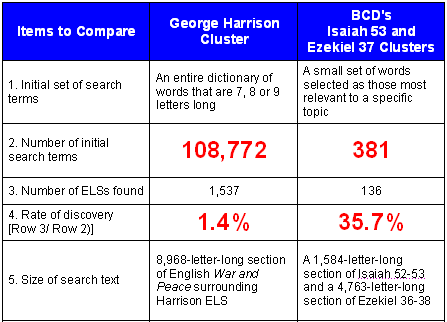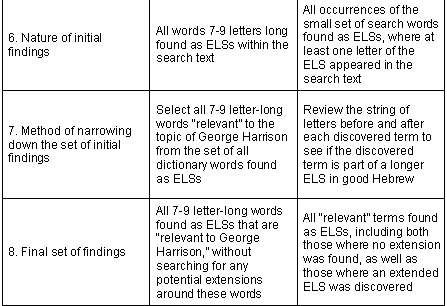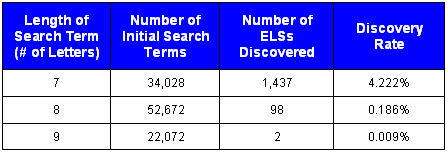| |
 Want Loads of Fish? Drain the Lake!
Want Loads of Fish? Drain the Lake!
Dave Thomas's avocation is explaining away claims of the supernatural. As a physicist, and activist associated with the New Mexicans for Science and Reason, this is a satisfying activity. He has also contributed articles to the magazine, Skeptical Inquirer. Many of Thomas's critiques of various claims are quite laudable. There is a great deal of nonsense out there (e.g., claims of psychic phenomena and UFOs), so it is often good that Thomas is on top of it, trying to snuff it out.
Thomas is adept at conjuring up counter-examples to illustrate that chance could produce something that someone had attributed to the miraculous. When Thomas encountered Michael Drosnin's books, he had a field day. He mimicked Drosnin's searches in an obviously non-encoded text, the English version of Tolstoy's novel War and Peace. In addition, Brendan McKay did the same in Herman Melville's novel Moby Dick. Together they have come up with some great examples that should let everyone know that Drosnin’s approach is truly bogus. For that we give them a standing ovation, as it is a message that many who are interested in Bible codes need to hear loud and clear and to fully appreciate.
When Thomas was asked by PAX-TV to participate in a debate with BCD's Ed Sherman on the program Faith Under Fire, moderated by Lee Strobel (which aired June 4, 2024), he cooked up yet another counter-example — this time designed to discredit BCD’s work and findings. Apparently he browsed a few pages from our site, still assuming that we were doing the Drosnin thing, and conjured up "the George Harrison" cluster from the English text of War and Peace as a counter-example of our findings. In doing this, Thomas noted a method we presented in July 2024 for rating clusters, and custom designed a "drain the lake" approach that would give his new example a reasonably high score.
Had Thomas given us the courtesy of reviewing his Harrison cluster before talking about it on national TV and posting it on his web site, we could have apprised him of how totally irrelevant his example was. I offered Thomas an opportunity to do that after the TV show aired and before he made his web posting. He refused, noting that he would rather debate Bible codes in public. So we were pre-judged. Thomas was very ready to assume that nothing good could come from Bible codes, no matter how the subject was approached.
Understanding the George Harrison cluster, and how it radically differs from BCD's cluster, is an instructive exercise. The two types of clusters are the result of totally opposite processes. The Harrison cluster is the result of an exhaustive, "drain the lake" approach, while BCD clusters are the result of a highly targeted investigation. The following table summarizes the key differences.



It is clear that Dave Thomas's example is the result of a process that is totally different from BCD's clusters. The primary common element is that both involve ELSs found by a search program, but the similarity ends there. It is hard to imagine how anyone could come up with a comparison more irrelevant and unscientific than Dave Thomas has. In reality, his comparison is much worse than the proverbial one of apples and oranges. It is more like comparing all the grapes in a large vineyard with the watermelons in a small garden patch. Yes. The grapes and watermelons have a similar shape, but, beyond that, there is no comparison.
One may ask why the number of ELSs found by BCD, as shown in rows 3 and 10 in the above table, is different. The 136 in row 3 is the number of times that a longer ELS was found, either before and/or after the initially discovered ELS, as reported in Bible Code Bombshell. The 151 is the total number of ELSs discovered that consisted of nine or more letters, including some ELSs discovered recently — after Bombshell was finalized. So there are two sources of difference: (1) ELS discoveries made after Bombshell was finalized, and (2) some initial ELSs were nine or more letters long (and no extension was found), so such ELSs would not be included in the count for row 3, but would be included in row 10.
What can we learn from the comparison presented in the table above?
- As Thomas has demonstrated by his George Harrison cluster, if all you do is look for single words as ELSs in a text, you will find many words about whatever topic you choose. Thomas was right when he said in the debate that this method is "totally subjective" and that you will find whatever you are looking for if you look long enough.
- BCD's clusters are the result of a totally different process that bears very little resemblance to the Drosnin approach Thomas has discredited. Thomas has done a great job beating a dead horse, but there are other horses on the farm that still roam alive and well.
- How much one finds is of course affected by how much one looks for. Thomas searched for every seven, eight and nine letter word in the dictionary, and so he found many single words. There is an enormous difference, however, between searching for 108,772 words, as Thomas did, and searching for 381 words, as BCD did. For every word BCD searched for, Thomas searched for 285 words!
- What is far more to the point is a comparison of the rates of discovery of ELSs within each search text. Thomas's discovery rate is a pathetic 1.4% while BCD's was 35.7%, an enormous and telling difference. While a fair amount of this difference is due to differences between English and Hebrew as languages, a large difference would still remain even after adjusting for this.
- The discovery rate for Thomas's searches drops like a rock as the length of the search term increases by just one letter. As the next table shows, Thomas's discovery rate for seven-letter-long words was 4.2%, but only 0.186% for eight-letter-long words and only 0.009% for nine-letter-long words. This strongly confirms the fact that it is much harder to find longer ELSs than shorter ones.
Comparison of Dave Thomas's ELS Discovery Rates
(By Length of Search Term)

The proper conclusion to draw from the above table is that longer terms are much harder to find than shorter ones. Given that many ELSs presented by BCD (and other researchers) are much longer than anything Dave Thomas could locate in a non-encoded text, he was faced with the possibility that the Bible might be encoded. So, he took the only available "out" and belittled the Hebrew in published codes.
Quality of Hebrew Issues
Even though Mr. Thomas has basically discredited himself by his inability to produce an ELS counter-example that bears even the slightest resemblance to published code clusters, that did not stop him from asking us to trust his reporting regarding the opinions of two Hebrew scholars. Near the end of Dave Thomas's posting regarding BCD's Cluster Rating System, he alleges that the quality of the Hebrew in the code findings BCD has presented is not acceptable. He cites the opinions of two "respected Hebrew scholars in Albuquerque." While it is good that he at least disclosed their names, he does not offer any further details regarding their credentials. There are many people who claim a knowledge of Hebrew, but it is based on a few courses and little or no actual experience in speaking and reading the language. Perhaps these "respected Hebrew scholars" know 10,000 Hebrew words — a respectable number. In contrast, our expert, Dr. Nathan Jacobi, was educated in Israel from age six through his receipt of a doctorate (1945-1969), gaining a very thorough knowledge of both Biblical and contemporary Hebrew. In graduate school, he served as an interpreter (from English to Hebrew) of courses taught at the Weizman Institute of Science. He lectured at the Tel-Aviv University in Hebrew. He has taught numerous classes on Hebrew in recent years (1998-2003). Every day, he reads the news in Hebrew from an Israeli website (HaAretz). He normally converses with his Israeli wife in Hebrew and is in very regular communication in Hebrew with his two children, both of whom live in Israel.
Rather than just knowing 10,000 Hebrew words, suppose that Dr. Jacobi knows 50,000. If someone with respectable Hebrew knowledge were asked to comment on the quality of Hebrew of someone like Dr. Jacobi, their criticisms would be predictable (and much like what Dave Thomas cites):
- "Several missing letters." Many words in comtemporary Hebrew include yods and vavs not present in Biblical Hebrew.
- "So convoluted." To someone with a solid basic knowledge of Hebrew, the phrases and sentences of someone with an advanced, lifetime facility in the language could easily seem convoluted.
- "Grammatical problems and errors." Same comment as for #2.
Thomas also complains about Dr. Jacobi using a modern euphemism for God (yod-yod) in a few codes. We are surprised that a non-religious person would hold such strong opinions about what God would or would not do if He were to embed codes. Is God constricted by Dave Thomas? Instead of pre-judging God, Mr. Thomas might do better to maintain an open mind about codes and to simply report what he has observed. That is what Dr. Jacobi did. He encountered a yod-yod in a potential extension of an ELS and translated it using a modern euphemism, because it fit within the context.
Hebrew expert Moshe Aharon Shak had this to say on Thomas's concern about BCD's usage of yod-yod as a reference to God: "In today's Jewish prayer books the term yud-yud is used EXTENSIVELY! An orthodox Jew sees the term NUMEROUS times each time he prays! An orthodox Jew prays three times a day . . . " Shak also adds, "Codes were discovered today to be used by today's readers. For example, the term Shoa, or holocaust was not used until only recently. Only after the recent holocaust was the term entered into the Hebrew dictionary."
A few years ago, BCD conducted the Arab Nations experiment. In that experiment, the five occurrences with the shortest skips of the names of about a dozen Arab nations as ELSs in the book of Ezekiel were noted. A parallel set of ELSs was located in a segment of a Hebrew translation of War and Peace of a similar length. BCD then sent these ELSs together with the string of letters before and after the names of the Arab nations to Dr. Jacobi to examine for the possible presence of phrases or sentences including the name of the Arab nation. We sent the same ELSs and surrounding strings to another Hebrew expert, Moshe Aharon Shak, a Canadian engineer who has spoken Hebrew consistently throughout his life. A careful comparison of the findings of Dr. Jacobi and Mr. Shak will show that in a high percentage of cases, the Hebrew translations of the two experts were the same or very similar to one another.
There are different types of translation. The most common are: (1) literal; (2) dynamic equivalent; (3) paraphrased; and (4) interpretative. The first is essentially word-for-word, with no modification to help the non-Hebrew speaking person to deal with peculiar Hebrew idioms, etc. With a dynamic equivalent translation, the translator works phrase by phrase, or sentence by sentence, to express the same thought(s), but within English idioms. With a paraphrase, the translator exercises even more freedom in trying to convey the original message, not being concerned with using the key Hebrew words that are in the Hebrew that is being translated. In an interpretative translation, the translator paraphrases the text while also offering plausible substitutes for general terms in the original text. Dr. Jacobi's translations include all four types. Obviously, if the translation is not of the first type, someone working with a translation dictionary will often not be able to follow what has occurred in the translation. The longer the code presented, the more likely that the translation presented by BCD will not be simply a literal one.
Thomas tries to make hay with the observation that BCD categorized our 20 longest code findings into three categories of Hebrew quality: (1) Good, (2) Acceptable and (3) Marginal. We made these categorizations to give our readers a better appreciation for the existence of variations of Hebrew quality within long codes — due in large part to the presence of different types of translations, as enumerated above. In reality, seeming examples of all three types of Hebrew quality can be presented from the Hebrew Bible itself. Shak offered such a seeming example from Exodus 19:2. "Check the verb of 'they departed'. Note that it is in the plural tense. Next check the verb 'camped'. Note that it is in the singular tense . . . There, someone somewhere did not know Hebrew . . . Not a chance."
On this issue, Shak added, "Take the word 'Toldot' ('generations')   . There are four ways to spell it in the Bible. With a vav here, then there, then everywhere, then nowhere. Is this a proof that four different 'people' wrote the Bible? There are many other such illogical 'proofs' that were torn apart a long time ago." . There are four ways to spell it in the Bible. With a vav here, then there, then everywhere, then nowhere. Is this a proof that four different 'people' wrote the Bible? There are many other such illogical 'proofs' that were torn apart a long time ago."
Finally, in the last five years the BCD website has been visited by over 2,000,000 people from around the world, including a significant number of people from Israel. We receive a large volume of e-mail every day from people who are more than willing to give us a piece of their mind. And yet, we have only received e-mails from five people expressing concerns about the quality of Hebrew on our web site. Three of them are leading skeptics of Bible codes — Brendan McKay, Dave Thomas and Randy Ingermanson, none of whom are Hebrew experts. Isn't it curious that there should be such a virtual absence of complaint — except from those who have such a strong vested interest in alleging poor Hebrew as a way of discounting BCD's findings? These skeptics are smart enough to realize that if the quality of Hebrew in BCD's findings is reasonable, they are dead wrong. So they have no alternative but to attack it.
|
Enjoy finding your own Bible codes.
Bible code search software is available in our online store.
Subscribe Free! Sign Up Today!
Become a member of the non-profit Isaac Newton Bible Code Research Society.
Not only will you be part of the world's leading organization researching and publicizing Bible and Torah codes, but you will receive Bible Code Digest absolutely free, including . . .
- Latest Bible Code News
- Easy-to-Understand Bible Code Feature Articles
- Exciting Inside Information from Leading Code Researchers
- Details of Great New Discoveries
- Summaries of the Latest Battles Between Code Proponents and Skeptics
Stay current on Bible code news. Be first to hear about all of the latest Bible code discoveries.
Sign up to receive Bible Code Digest today.
|
|





 |









